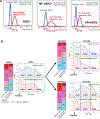Durvalumab with olaparib and paclitaxel for high-risk HER2-negative stage II/III breast cancer: Results from the adaptively randomized I-SPY2 trial
- PMID: 34143979
- PMCID: PMC11064785
- DOI: 10.1016/j.ccell.2021.05.009
Durvalumab with olaparib and paclitaxel for high-risk HER2-negative stage II/III breast cancer: Results from the adaptively randomized I-SPY2 trial
Abstract
The combination of PD-L1 inhibitor durvalumab and PARP inhibitor olaparib added to standard paclitaxel neoadjuvant chemotherapy (durvalumab/olaparib/paclitaxel [DOP]) was investigated in the phase II I-SPY2 trial of stage II/III HER2-negative breast cancer. Seventy-three participants were randomized to DOP and 299 to standard of care (paclitaxel) control. DOP increased pathologic complete response (pCR) rates in all HER2-negative (20%-37%), hormone receptor (HR)-positive/HER2-negative (14%-28%), and triple-negative breast cancer (TNBC) (27%-47%). In HR-positive/HER2-negative cancers, MammaPrint ultra-high (MP2) cases benefited selectively from DOP (pCR 64% versus 22%), no benefit was seen in MP1 cancers (pCR 9% versus 10%). Overall, 12.3% of patients in the DOP arm experienced immune-related grade 3 adverse events versus 1.3% in control. Gene expression signatures associated with immune response were positively associated with pCR in both arms, while a mast cell signature was associated with non-pCR. DOP has superior efficacy over standard neoadjuvant chemotherapy in HER2-negative breast cancer, particularly in a highly sensitive subset of high-risk HR-positive/HER2-negative patients.
Keywords: DNA repair inhibitor; breast cancer; clinical trial; immunotherapy.
Copyright © 2021 Elsevier Inc. All rights reserved.
Conflict of interest statement
Declaration of interests L. Pusztai has received consulting fees and honoraria from Pfizer, AstraZeneca, Merck, Novartis, Bristol-Myers Squibb Genentech, Eisai, Pieris, Immunomedics, Seattle Genetics, Clovis, Syndax, H3Bio, and Daiichi, and Nanostring research support to his institution from AstraZeneca, Pfizer, Merck, Seagen, and Bristol Myers Squibb. H.S. Han: research funding to institution from GlaxoSmithKline, Abbvie, Prescient, G1 Therapeutics, Marker Therapeutics, Novartis, Horizon Pharma, Quantum Leap Healthcare Collaborative, Pfizer, Seattle Genetics, Arvinas, Zymeworks; grants from the Department of Defense, Speaker’s Bureau - Lilly. E. String-Reasor: Consulting Lilly; Susan G. Komen, BCRFA, V Foundation research funding. J.C. Boughey: research funding from Eli Lilly. A.J. Chien: institutional research funding from Seagen, Merck, Amgen, and Puma. R. Nanda: research funding from Arvinas, AstraZeneca, Celgene, Corcept Therapeutics, Genentech/Roche, Immunomedics/Gilead, Merck, OBI Pharm, Inc., Odonate Therapeutics, OncoSec, Pfizer, Taiho, SeaGen. A.S. Clark: research funding from Novartis. K. Kalinsky has disclosed advisory/consulting funding from Eli-Lilly, Pfizer, Novartis, Eisai, AstraZeneca, Immunomedics, Merck, Seattle Genetics, OncoSec, 4D Pharma, DaicchiSankyo, and Cyclocel. Dr. Kalinsky also reports financial disclosures for his spouse (stock): Grail, Array BioPharma and Pfizer (prior employee). C. Isaacs has received consulting fees from Seattle Genetics, Genentech, AstraZeneca, Novartis, PUMA, Pfizer, and Esai. A. Thomas declares research support (paid to the institution) from Seattle Genetics, Sanofi; stock ownership in Johnson and Johnson, Bristol Myers Squibb, Pfizer, and Gilead; and participation in DSMB (BeyondSpring Pharmaceuticals; and royalties from Up-to-Date). A. Forero-Torres became a Seattle Genetics employee in 2018, and holds stock option from this employment. M.C. Liu received clinical trial research support from Eisai, Genentech, GRAIL, Menarini Silicon Biosystems, Merck, Novartis, Seattle Genetics, and Tesaro. M. Melisko received research funding to the institution from AstraZeneca, Novartis, KCRN Research, and Puma, and consulting fees from Biotheranostics, their spouse received honoraria from Genentech and has stock ownership in Merrimack. E.F. Petricoin: leadership roles in Perthera, Ceres Nanosciences; stock and other ownership interests in Perthera, Ceres Nanosciences, Avant Diagnostics; consulting or advisory roles in Perthera, Ceres Nanosciences, AZGen, Avant Diagnostics; research funding from Ceres Nanosciences (Inst), GlaxoSmithKline (Inst), Abbvie (Inst), Symphogen (Inst), Genentech (Inst); patents, royalties, other intellectual property (National Institutes of Health patents licensing fee distribution/royalty; co-inventor on filed George Mason University–assigned patents related to phosphorylated HER2 and EGFR response predictors for HER family-directed therapeutics, as such can receive royalties and licensing distribution on any licensed IP; travel, accommodations, and expenses from Perthera, Ceres Nanosciences. J.D. Wulfkuhle received honoraria from DAVA Oncology and consults for Baylor College of Medicine, and has disclosed stock ownership in Theralink Technologies, Inc. H.S. Rugo has received research support for clinical trials through the University of California from Pfizer, Merck, Novartis, Lilly, Genentech, Odonate, Daiichi, Seattle Genetics, Eisai, Macrogenics, Sermonix, Boehringer Ingelheim, Polyphor, AstraZeneca, and Immunomedics; and Honoraria from Puma, Mylan, and Samsung. L.J. van’t Veer is employed by and a stockholder of Agendia NV. L.J. Esserman is an unpaid member of the board of directors of Quantum Leap Healthcare Collaborative, and received grant funding from QLHC for the I-SPY TRIAL; and is a member of the Blue Cross/Blue Shield Medical Advisory Panel and receives reimbursement for her time and travel. She has a grant from Merck for an Investigator initiated trial of DCIS. The following authors declare no competing interests: C.Y., D.M.W., L.D., A.M.W., A.D., E.H.B., K.S.A., R. Shatsky, L.S., S.M.A., A.W., R. Singhrao, L.S., G.L.H., S.M.B., A.A., J.P., R.B.S., D.Y., N.M.H., K. Kemmer, T.L.H., A.S., J.B.M., W.F.S., A.M.D., and D.A.B.
Figures



Comment in
-
I-SPY2 platform: New lessons from the olaparib and durvalumab combination in breast cancer treatment.Cancer Cell. 2021 Jul 12;39(7):902-904. doi: 10.1016/j.ccell.2021.06.008. Cancer Cell. 2021. PMID: 34256905
References
-
- Barker A, Sigman C, Kelloff G, Hylton N, Berry D, and Esserman L (2009). ISPY 2: An Adaptive Breast Cancer Trial Design in the Setting of Neoadjuvant Chemotherapy. Clin Pharmacol Ther 86, 97–100. - PubMed
-
- Berry DA (2011). Adaptive clinical trials in oncology. Nature Reviews Clinical Oncology 9, 199–207. - PubMed
-
- Berry SM, Reese CS, and Larkey PD (2012). Bridging Different Eras in Sports. J Am Stat Assoc 94, 661–676.
-
- Bianchini G, Pusztai L, Karn T, Iwamoto T, Rody A, Kelly CM, Müller V, Schmidt M, Qi Y, Holtrich U, et al. (2013). Proliferation and estrogen signaling can distinguish patients at risk for early versus late relapse among estrogen receptor positive breast cancers. Breast Cancer Res 15, R86. - PMC - PubMed
Publication types
MeSH terms
Substances
Grants and funding
LinkOut - more resources
Full Text Sources
Other Literature Sources
Medical
Molecular Biology Databases
Research Materials
Miscellaneous

